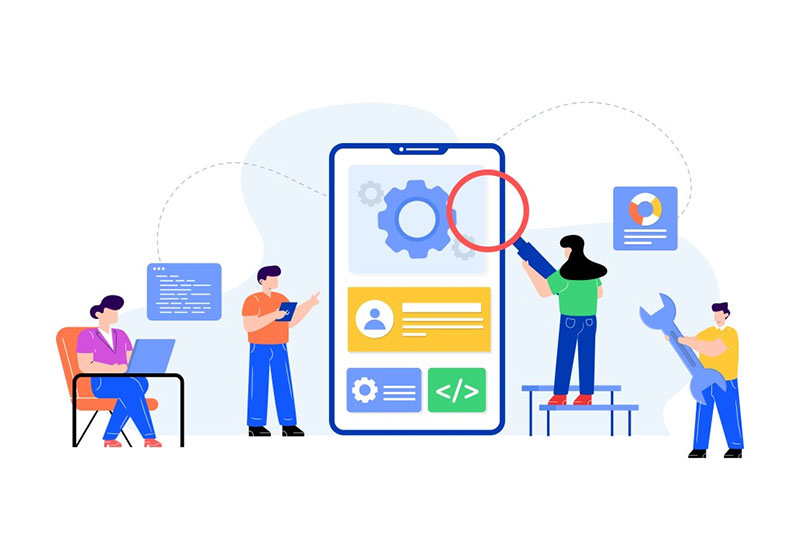Responsive Design: Crafting Websites For Every Device

In today’s fast-paced digital age, where smartphones, tablets, and various other devices have become integral to our lives, websites must adapt to the varying screen sizes and resolutions. This is where responsive design comes into play. Responsive web design is an approach that enables websites to automatically adjust and optimize their layout and content based on the device being used to access them. By seamlessly adapting to different screen sizes and resolutions, responsive design ensures a consistent and user-friendly experience for visitors, regardless of the device they prefer to use.
The importance of responsive web design cannot be underestimated. With the rapid growth of mobile technology and the increasing number of people accessing the internet on mobile devices, websites must be responsive. A responsive design ensures that your website looks and functions flawlessly, regardless of whether it’s being viewed on a desktop, laptop, tablet, or smartphone. By providing a consistent and optimized user experience across all devices, responsive design ultimately enhances user engagement, boosts conversion rates, and improves search engine rankings.
In our multi-device world, where users expect to access information on the go and across various screens, responsive design has become more relevant than ever. With the increasing diversity of devices and screen sizes, businesses and website owners must embrace responsive design to cater to their audience effectively. By crafting responsive websites, businesses can stay ahead of the curve, reaching and engaging users across all devices and providing a seamless browsing experience that keeps users returning for more.
Let’s delve more into this topic in this article.
Understanding The Need For Responsive Design
In today’s digital landscape, the diversity of devices is ever-expanding. From smartphones and tablets to laptops and desktops, users have many options for accessing the internet. Each of these devices comes with its own screen size, resolution, and capabilities, making it essential for websites to adapt and cater to this diversity. This is where responsive design plays a crucial role.
In a mobile-first era, user expectations have evolved significantly. With most internet traffic now coming from mobile devices, users expect websites to be accessible and functional on their smartphones and tablets. They want to be able to find information, make purchases, or engage with content seamlessly, regardless of the device they are using. Responsive design addresses this need by automatically adjusting the layout and content of a website to fit different screen sizes and resolutions. This ensures users have a consistent and user-friendly experience, regardless of their chosen device.
The impact of responsive design on user experience and engagement is substantial. A website that is not responsive may display improperly on certain devices, leading to a frustrating and disjointed user experience. Users may have to zoom in and out or scroll horizontally to view content, resulting in a subpar browsing experience. On the other hand, a responsive website analyzes the user’s device. It optimizes the layout and content, providing a seamless and visually pleasing experience. This, in turn, increases user engagement and encourages longer browsing sessions, ultimately leading to improved conversion rates and customer satisfaction. By embracing responsive design, businesses and website owners can ensure they meet user expectations, enhance the overall user experience, and stay ahead of the competition in this mobile-first era. Go to this website to harness this benefit for your business, too!
Core Principles Of Responsive Design
To create websites that truly cater to every device, it is essential to understand and implement the core principles of responsive design. These principles provide a foundation for crafting flexible and adaptive websites that seamlessly adjust to screen sizes and resolutions.
One of the fundamental principles of responsive design is using fluid grids. Unlike fixed-width layouts, fluid grids allow website elements to scale proportionally based on the screen size. This means that no matter the device being used, the website will intelligently arrange its content to maintain a harmonious and visually pleasing layout. By designing with fluid grids, web designers can ensure that their websites are flexible and responsive, providing an optimal viewing experience on any device.
In addition to fluid grids, flexible images and media play a crucial role in responsive design. Images and media elements like videos and slideshows should be able to adapt to different screen sizes without losing their quality or functionality. Web designers can use CSS techniques such as max-width: 100% to ensure that images and media scale proportionally to fit the available screen space. This prevents images from overflowing or becoming too small, maintaining a visually appealing and engaging user experience.
Another essential tool in the arsenal of responsive design is media queries. Media queries allow web designers to apply specific styles to different devices or screen sizes, tailoring the design to ensure optimal viewing. By utilizing media queries, web designers can set breakpoints to adapt the website layout and styling to accommodate specific device dimensions. This allows for a seamless transition across different screen sizes and resolutions, optimizing the user experience.
Finally, in crafting websites for every device, accessibility considerations should not be overlooked. Responsive design should prioritize creating an inclusive and usable website for everyone, regardless of ability. This includes providing alternatives for non-text content, using color combinations accessible for individuals with color blindness, and ensuring that interactive elements are easily navigable using different input methods. By incorporating accessibility best practices into responsive design, websites can be truly inclusive and user-friendly.
Technological Foundations Of Responsive Design
Responsive design is based on various technological foundations, which help designers achieve an adaptive and flexible layout that works seamlessly across different devices. From front-end frameworks to coding languages, here are some of the primary technological foundations of responsive design.
HTML5, the latest version of HTML (HyperText Markup Language), plays a crucial role in responsive design. HTML5 provides a variety of new and updated elements that allow designers to create more semantic code that works better with responsive design. Some helpful HTML5 elements include <article>, <nav>, and <header> tags, which provide more semantic information about page content. Additionally, HTML5 provides new form controls, such as input types like ‘date,’ ‘search,’ and ‘range,’ that allow for better input control on different devices.
CSS (Cascading Style Sheets) is the styling language of the web, and CSS3 provides several new properties that aid in creating responsive design. One particularly important CSS3 feature is Media Queries, which allows site styles to adjust to the screen size of the user’s device. With Media Queries, web designers can define different styles or layouts for specific screen sizes, making a design more versatile and inclusive.
JavaScript is the primary interactive language of the web, and it can be used alongside HTML and CSS to add dynamic functionality that supports responsive design. JavaScript is essential for creating Interactive forms, drop-down menus, and various dynamic user interface elements that improve site usability. The key to using JavaScript in responsive design is to employ Progressive Enhancement practices. By ensuring that a site’s core functionality works on older devices with less advanced features, Progressive Enhancement creates a user experience that works for everyone, no matter the device.
Frameworks and tools can help implement responsive design, especially for designers with expertise in other areas. Tools like Bootstrap and Foundation provide pre-built sets of CSS and JavaScript files that handle common responsive design issues like media queries, image resizing, and layout. These frameworks can save designers time and effort while still allowing for customization.
Design Process And Workflow

The design process and workflow for responsive design are crucial in ensuring that websites are crafted effectively for every device. Following a well-defined process, designers can create responsive layouts that adapt seamlessly to various screen sizes and devices. Here are some key steps in the design process specific to crafting websites for every device.
Planning and designing for responsiveness is an essential initial step in the process. It involves understanding the target audience, device preferences, and usage patterns. By gathering this information, designers can develop a solid understanding of the design requirements and plan accordingly. This includes identifying the content hierarchy, designing an appropriate navigation structure, and determining which elements are critical to display on all devices.
Regarding designing for responsiveness, there are two main approaches: mobile-first and desktop-first. The mobile-first approach involves designing the website layout and functionality for mobile devices first and then progressively enhancing it for larger screens. This approach prioritizes simplicity and ensures that the most crucial content and functionality are available on smaller devices. In contrast, the desktop-first approach initially focuses on designing for larger screens and subsequently adapting it for smaller devices. This approach provides more design freedom but may require more effort to optimize for mobile.
Creating wireframes and prototypes for responsive layouts is essential in the design process. Wireframes help designers establish the website’s structure, layout, and content hierarchy without getting into detailed visual elements. Prototypes, on the other hand, enable designers to test and refine the responsive behavior of the website. By creating wireframes and prototypes tailored for responsive design, designers can visualize and test how the layout adapts to different screen sizes and devices.
Testing and optimizing for different devices is a critical aspect of the design workflow. It involves comprehensive testing on different devices and screen sizes to ensure a consistent and optimal user experience. Designers should test the website’s functionality, layout, and performance across various devices, including smartphones, tablets, laptops, and desktops. This testing phase helps identify any responsive design issues and allows for adjustments and optimizations to be made accordingly.
Collaboration and communication between designers, developers, and stakeholders are necessary throughout the design process to ensure the successful implementation of responsive design. Regular feedback loops and iterative design cycles should be incorporated to refine the responsive design and address usability or performance concerns.
Challenges In Responsive Design
Responsive design is a powerful approach to creating websites that adapt seamlessly to different devices. Still, it also comes with its own set of challenges. Overcoming these challenges is essential to ensure that websites are truly crafted for every device. Here are some of the key challenges faced in responsive design:
- Handling Cross-browser Compatibility
One of the most significant challenges in responsive design is ensuring that websites function and display correctly across different browsers. Each browser interprets HTML, CSS, and JavaScript differently, which can lead to inconsistent layouts and functionality. Designers must thoroughly test their responsive designs across multiple browsers and devices, identify compatibility issues, and make necessary adjustments to ensure a consistent user experience.
- Performance Optimization
Responsive websites must load quickly and efficiently on all devices, regardless of network conditions. Performance optimization is critical to prevent slow loading times, especially on mobile devices with slower internet connections. Designers must consider elements like image sizes, file compression techniques, and code optimization to minimize page load times and boost website performance across all devices.
- Maintaining Design Consistency Across Devices
Design consistency is vital to provide users with a cohesive experience, regardless of their device. However, achieving design consistency can be challenging due to screen size, resolution, and aspect ratio differences. Designers must carefully balance the layout and visual elements to ensure the design remains aesthetically pleasing and functional across different devices. Techniques like grid systems and fluid layouts can help maintain consistency while adapting to varying screen sizes.
- Navigational Challenges In Responsive Design
Navigation plays a crucial role in user experience, and designing effective navigation for responsive websites can be complex. Traditional navigation menus may not work well on smaller screens, leading to usability issues. Designers must find innovative solutions to enable intuitive and user-friendly navigation, such as off-canvas menus, collapsible menus, or icons and gestures. A well-thought-out and easily accessible navigation system is essential for users to navigate the website effortlessly on any device.
To address these challenges, designers should adopt a user-centric and iterative approach to responsive design. Regular user testing and feedback can help identify potential issues and make necessary adjustments to improve compatibility, optimize performance, maintain design consistency, and provide seamless navigation across devices.
Conclusion
Responsive design is a transformative approach that allows websites to seamlessly adapt and provide a consistent user experience across various devices. In this article, we have explored the importance of responsive design and the challenges associated with crafting websites for every device. Responsive design is necessary in today’s mobile-centric world, where users access websites from various devices. By embracing responsive principles, designers can ensure that their websites are accessible and functional for everyone, regardless of their screen size or device. However, responsive design is not a static concept but an ever-evolving field. As technology advances and new devices emerge, the future of responsive web design looks promising. It will continue to push boundaries, requiring designers to keep learning and adapting to meet the evolving needs of users. Embracing responsive design principles is crucial to thrive in this digital landscape and provide exceptional user experiences across all devices.
- What is JavaScript? An Introduction to Web Programming - May 14, 2024
- Mastering Elixir for Long-Term Product Evolution - May 14, 2024
- Build Progressive Apps: Top PWA Frameworks to Use Now - May 14, 2024








